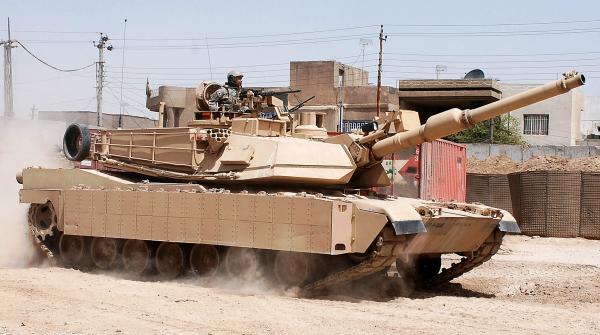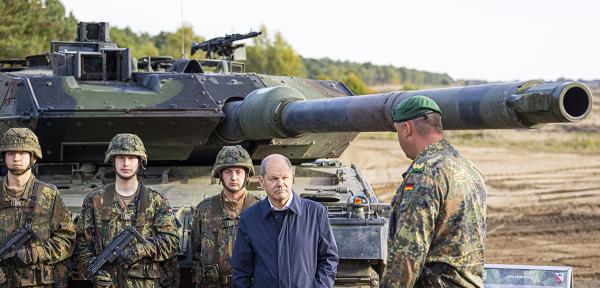
On January 25, 2023, President Biden made a commitment to send U.S. Army M1 Abrams tanks (above) to Ukraine.
The ongoing nearly year-long war in Ukraine is a horrific and brutal proxy war between predatory and rival imperialist powers—Russia on one side, and the U.S. and its NATO allies on the other. As we have reported previously, the U.S./NATO has been arming the Ukrainians in increasing waves and providing them military advice and tactical support and using them as cannon fodder in this proxy war. As U.S./NATO support for Ukraine in equipment, training, and intelligence, soared, so did the number of deaths. As of November, U.S. military leaders estimated that there had been at least 100,000 casualties on each side in the carnage of Ukraine.1
Over the winter months the war has been locked in a grinding, bloody stalemate, and many military analysts continue to see the possibility of a protracted conflict, albeit with escalated risks throughout. The U.S. itself seems to have strategically prepared for and is aiming for this. In April 2022, a month and a half after the war began, U.S. Army general Mark Milley, Chairman of the Joint Chiefs of Staff, said, “There is much of the ground war left in Ukraine, but I do think this is a very protracted conflict. And I think it's at least measured in years."
At the same time, and in this context, both sides have been feverishly preparing for the next stage of intensified battle in an effort to gain the upper hand this spring.2
Revolution wrote last week that both sides of this conflict “made a startling series of escalations over the past month alone. All this has made the danger of an even worse, yes possibly nuclear, war much greater.”
In the week since that was written, escalations have increasingly become active preparations for military operations. The U.S. and NATO began the process of sending to Ukraine a large number of modern battle tanks made mainly in the U.S., England, and Germany. As the New York Times assessed, this has “… inched the United States and its NATO allies closer to direct conflict with Russia.” The stakes for the people of Ukraine and Russia, and for all humanity, are enormous.
Bring in the Tanks
Volodymyr Zelensky, Ukraine’s president, has spent months publicly demanding hundreds of tanks from the U.S. and NATO, especially the German Leopard 2 tanks which are already plentiful not only in Germany but in other NATO countries. These tanks are highly mobile and lethal, supposedly have better armor than Russian tanks, and use navigation systems that enable them to work well with artillery and infantry in combined offensive operations. The U.S. has developed a carefully calibrated series of escalations in its backing of Ukraine, and right now, perceives this step with the tanks as a necessity at this moment.
After a series of negotiations and resolving disagreements, the U.S./NATO military leadership has made the assessment that a large infusion of battle tanks is critical for Ukrainian forces to defend against a Russian offensive this spring, and even take the offensive against entrenched Russian troops in the coming months. They want to possibly achieve decisive victories over Russia this year, and establish Ukrainian forces as dominant. Last week Jens Stoltenberg, NATO’s Secretary-General, argued that “At this pivotal moment in the war, we must provide heavier and more advanced systems to Ukraine. And we must do it faster.”
Biden and the U.S. wanted Germany to send its Leopard 2 tanks first, and claimed the American Abrams tank isn’t well-suited to the Ukrainian battlefield. Germany for various reasons had refused to be the first to allow use of its tanks in Ukraine until the U.S. made a similar commitment. After lengthy and contentious negotiations, this week Germany’s Chancellor (head of the government), Olaf Scholz, agreed to send 80 of Germany’s Leopard 2 tanks to Ukraine. Scholz’s move enabled other countries with Leopards to also commit them to Ukraine, which they couldn’t do without German permission.
Scholz’s announcement was almost immediately—and in parallel—followed by a commitment by Joe Biden to send U.S. Abrams tanks to Ukraine. Together these moves “unlock(ed) a flow of heavy European arms” to Ukraine. While most of these tanks won’t be operational immediately, their presence in Ukraine is intended to be “transformative” in the war—quickly, and in the long-term. They “… give the Ukrainian army additional firepower to smash through Russian defensive lines and seize the military initiative before Moscow can. They would also be needed to defend Ukrainian lines against a possible renewed Russian offensive later this year.”
Almost as soon as announcements about the tanks had been made, Volodymyr Zelensky said what Ukraine needs now are long-range missiles and fighter jets, and there are reports that discussions of this within NATO are “already under way.”

Chancellor Scholz with German army soldiers at a Leopard 2 tank like those being sent to Ukraine. Photo: AP
How Will This End?
On January 26, Bloomberg News reported that Vladimir Putin, Russia’s president, “is preparing a new offensive in Ukraine, at the same time steeling his country for a conflict with the U.S. and its allies that he expects to last for years.” The planned Russian offensive “may start as soon as February or March,” according to this report. That would be before the U.S. and most of the German tanks being sent to Ukraine would be operational. Russian troops are also undergoing extensive training in the country of Belarus, which borders both Russia and Ukraine. How the newly trained troops will be deployed is unclear. But the Belarusian Defense Ministry said that “Personnel, weapons, military and special equipment of the armed forces of the Russian Federation will continue to arrive in the Republic of Belarus."
At about the same time, Dmitry Medvedev, the deputy head of Russia’s Security Council, sent a chilling verbal warning to Western leaders who expect to defeat Russia in “conventional” warfare: “The loss of a nuclear power in a conventional war can provoke the outbreak of a nuclear war. Nuclear powers do not lose major conflicts on which their fate depends. This should be obvious to anyone. Even to a Western politician who has retained at least some trace of intelligence.” [Emphasis added]
How this seemingly endless ratcheting up of the level of inter-imperialist conflict will end is sharply contended by the various participants. Washington Post columnist Max Boot recently wrote that U.S. Defense Secretary Lloyd Austin told him that a “realistic goal for this year” would be for the Ukrainians to cut the “land bridge” between the peninsula of Crimea (which Russia seized in 2014)3 and Russia, a key supply route for the Russian forces. Setting forth the U.S./NATO goals for the year, he warned if that doesn’t happen, a “frozen conflict,” with Russian forces “squatting on the territory they currently occupy,” would result. But Zelensky insists that Russian troops must be driven out of all of Ukraine’s borders as they stood in 2014, which would mean re-taking all of Crimea, not just its land bridge.4 Russia’s leadership has insisted that Crimea is “an inseparable part of Russia,” along with other areas of eastern Ukraine which historically have had large populations of Russians. All of this makes for a volatile and shifting mix in objectives and in strategy.
The fact is, both the U.S./NATO side and Russia face tremendous necessity having entered into this conflict. And having done so—and driven by the logic of their mounting aggression—they are objectively trapped into a very deadly dynamic, and what in military/political terms is called an “escalation ladder.” This “escalation ladder” can ratchet up into far greater destruction and death—the potential of what is now proxy warfare going over into direct conflict between U.S./NATO and Russia, including the possible use of nuclear weapons. The further this war escalates, in the amount and type of weaponry used, the more dangerous it becomes—and the greater the possibility for it lurching into even more destructive conflict, perhaps nuclear war. All of this poses grave threats for humanity and cannot—and should not—be underestimated.
We can no longer afford to allow these imperialists to dominate the world and to determine the destiny of humanity. They need to be overthrown as quickly as possible.
—Bob Avakian, from the Bob Avakian Interviews
A Note from the Editors:
With each side seriously committed to its objectives, and having become seriously involved in war in pursuit of these objectives (with Russia directly at war in Ukraine and the U.S./NATO now indirectly but deeply involved), this means that, so long as the terms are set by these contending imperialists, neither side can easily back down. (Again, so long as the terms are set by these contending imperialists, and the people, on all sides, do not effectively act, in their masses, in such a way as to force things onto different terms, which are in their interests, in opposition to those of the imperialists on either side.)
–Bob Avakian, from “World War 3 and Dangerous Idiocy”
This insight from Bob Avakian sharply focuses the trajectory, the stakes for humanity and what is to be that the article above, “‘Calculated’ Risks in Ukraine War…,” exposes. For a lively discussion of this watch the conversation between Lenny Wolff and the host of the The RNL Show, Andy Zee.
Algorithmic Warfare and Kill Chains
Tanks are the most visible and provocative component of the massive amounts of weapons, training, and intelligence the U.S./NATO are providing to Ukraine now. But unprecedented development of a “digital battlefield” is also crucial to their efforts to defeat their imperialist rivals. Mark Milley, the U.S.’s top military official, said that “Tenacity, will and harnessing the latest technology give the Ukrainians a decisive advantage. We are witnessing the ways wars will be fought, and won, for years to come.”[Emphasis added]
“Algorithmic warfare” waged by the U.S./NATO allows NATO “advisors” outside Ukraine to peer through battlefield confusion and “quickly answer the essential questions of combat: Where are allied forces? Where is the enemy? Which weapons will be most effective against enemy positions? They can then deliver precise enemy location information to Ukrainian commanders in the field. And after action, they can assess whether their intelligence was accurate and update the system.”
In plain language, this is what the U.S. military calls its “kill chain”: high-tech precision technology—made in America—combines with cold-blooded lethality on a “vast scale” to obtain a higher kill rate. The chief executive of the company that designed and manufactured these systems told a reporter that the power of these advanced algorithmic warfare systems “equate to having tactical nuclear weapons against an adversary with only conventional ones.”
